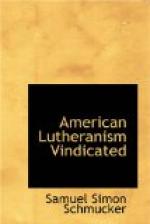Again, if we may believe Luther himself, they certainly did a afterward change their ground in regard to the jurisdiction of the Pope and bishops. Hear his own language in 1533, three years later: “Hitherto we have always, and especially at the diet of Augsburg, very humbly offered to the Pope and bishops, that we would not destroy their ecclesiastical right and power, but that we would gladly be consecrated and governed by them, and aid in maintaining their prerogatives and power, if they would not force upon us articles too unchristian. But we have been unable to obtain this; on the contrary, they wish to force us away from the truth, to adopt their lies and abominations, or wish us put to death. If now, (as they are such hardened Pharaohs,) their authority and consecration should fare as their indulgences did, whose fault will it be?” He then proceeds to denounce the power and consecration which he had admitted at the time of the Augsburg Diet, and declares the church’s entire independence of Rome for ordination. [Note 1]
Again, the Preamble asserts, “That the entire Lutheran Church of Germany has rejected the symbolical books as a whole, and also abandoned some of the doctrines of the Augsburg Confession, among others the far greater part of them, the doctrine of the bodily presence of the Saviour in the eucharist.”
The truth of these positions is well known to those acquainted with the churches in Germany generally. A few extracts from standard authorities may be pleasing to those not well informed on this subject. Says Koellner, in 1837: “The theologians of more recent times have, as a body, departed from the rigid doctrinal system of the symbols, and let it be particularly noted, not only those who in the opposing parties are termed rationalists, but also those who, in antithesis to these, desire to be regarded as champions for the doctrines of the church.




